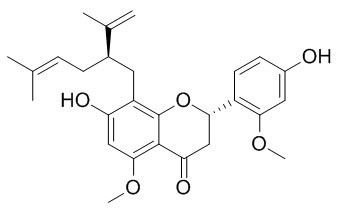2'-Methoxykurarinone
2'-Methoxykurarinone has strong alpha-glucosidase inhibitory activities, with IC(50) values of 155 microM. 2'-Methoxykurarinone is a noncompetitive inhibitor of protein tyrosine phosphatase 1B, it exhibits cellular activity in the insulin signaling pathway by increasing the insulin-stimulated Akt phosphorylation level in human hepatocellular liver carcinoma HepG2 cells, suggesting its potential for new anti-insulin-resistant drug developments. 2′-Methoxykurarinone exhibits lethal activity against Trypanosoma cruzi.,the minimum lethal concentrations is 6.9 uM.
Inquire / Order:
manager@chemfaces.com
Technical Inquiries:
service@chemfaces.com
Tel:
+86-27-84237783
Fax:
+86-27-84254680
Address:
1 Building, No. 83, CheCheng Rd., Wuhan Economic and Technological Development Zone, Wuhan, Hubei 430056, PRC
Providing storage is as stated on the product vial and the vial is kept tightly sealed, the product can be stored for up to
24 months(2-8C).
Wherever possible, you should prepare and use solutions on the same day. However, if you need to make up stock solutions in advance, we recommend that you store the solution as aliquots in tightly sealed vials at -20C. Generally, these will be useable for up to two weeks. Before use, and prior to opening the vial we recommend that you allow your product to equilibrate to room temperature for at least 1 hour.
Need more advice on solubility, usage and handling? Please email to: service@chemfaces.com
The packaging of the product may have turned upside down during transportation, resulting in the natural compounds adhering to the neck or cap of the vial. take the vial out of its packaging and gently shake to let the compounds fall to the bottom of the vial. for liquid products, centrifuge at 200-500 RPM to gather the liquid at the bottom of the vial. try to avoid loss or contamination during handling.
iScience.2023, 26(9):107602.
Pamukkale Medical Journal2022, 15(4):796-803.
Antioxidants.2022, 11(3):491.
Iranian Journal of Pharmaceutical Sciences2021, 17(2):25-36
Sci Rep.2024, 14(1):23786.
Food Chem.2016, 191:81-90
Evid Based Complement Alternat Med.2022, 2022:3483511
J Appl Pharm Sci.2022, 12(04):044-053
Int J Mol Sci.2024, 25(17):9730.
Natural Product Sciences2024, 30(4):254-261.
Related and Featured Products
Planta Med., 2014, 80(7):557-60.
Protein tyrosine phosphatase 1B inhibitory activity of lavandulyl flavonoids from roots of Sophora flavescens.[Pubmed:
24782228]
Protein tyrosine phosphatase 1B is a non-transmembrane protein tyrosine phosphatase and major negative regulator in insulin signaling cascades, and much attention has been paid to protein tyrosine phosphatase 1B inhibitors as potential therapies for diabetes.
METHODS AND RESULTS:
The screening of a natural compound library led to the discovery of five lavandulyl flavonoids, which were isolated from the roots of Sophora flavescens, as novel PTP1B inhibitors: kuraridin (1), norkurarinone (2), kurarinone (3), 2'-Methoxykurarinone (4), and kushenol T (5). The three most potent compounds, 1, 2, and 4 (IC50 < 30 μM), were demonstrated to be noncompetitive inhibitors of protein tyrosine phosphatase 1B based on a kinetic analysis, and they exhibited different inhibitory selectivities against four homologous protein tyrosine phosphatases (T cell protein tyrosine phosphatase, vaccinia H1-related phosphatase, and Src homology domain 2-containing protein tyrosine phosphatases 1 and 2).
Natural Medicines, 2003, 57:253-5.
Trypanocidal Flavonoids from Sophora flavescens[Reference:
WebLink]
The acetone extract of Sophora flavescens Aiton (Leguminosae) exhibited lethal activity against Trypanosoma cruzi.
METHODS AND RESULTS:
Column chromatographic separation of the extract guided by trypanocidal activity afforded a new prenylated flavanone (4), together with nine known flavonoids: sophoraflavanone G (1), (-) -kurarinone (2), kushenol L (3), 2'-Methoxykurarinone, (5), 7,4′-dihydroxy-5-methoxy-8-(γ,γ-dimethylallyl)-flavanone (6), leachianone A (7), 8-prenylnaringenin (8), noranhydroicaritin (9) and alopecurone G (10). The structure of the new flavanone 4 was determined on the basis of spectroscopic analyses.
CONCLUSIONS:
The minimum lethal concentrations of these compounds against epimastigotes of T. cruzi were 3.7 μM (1), 14 μM (2), 7.1 μM (3), 7.2 μM (4), 6.9 μM (5), 71 μM (6), 5.5 μM (7), 18 μM (8), 4.4 μM (9) and 3.6 μM (10).
Biol. Pharm. Bull., 2006, 29(2):302-5.
Glycosidase inhibitory flavonoids from Sophora flavescens.[Pubmed:
16462036]
The methanol extract of Sophora flavescens showed a potent glycosidase inhibitory activity.
METHODS AND RESULTS:
Active components were identified as well-known flavonoid antioxidants: kushenol A (1), (-)-kurarinone (2), sophoraflavanone G (3), 2'-Methoxykurarinone (4), kurarinol (5), 8-prenylkaempferol (6), isoxanthohumol (7), kuraridin (8) and maackian (9). All flavonoids were effective inhibitors of alpha-glucosidase and beta-amylase. Interestingly, lavandulylated flavanones 1-5 had strong alpha-glucosidase inhibitory activities, with IC(50) values of 45 microM, 68 microM, 37 microM, 155 microM and 179 microM, respectively. Kushenol A (1) which does not bear a 4'-hydroxy group showed selective alpha-glucosidase inhibitory activity. Lavandulylated chalcone, kuraridine (8), exhibited IC(50) value of 57 microM against beta-glucosidase, which is the first report of a chalcone displaying glycosidase inhibition.
CONCLUSIONS:
Results showed that 8-lavandulyl group in B-ring was a key factor of the glycosidase inhibitory activities. The inhibition pattern was noncompetitive for alpha-glucosidase, whereas mixed inhibition was observed for beta-amylase.



